Every time a business faces uncertainty across the landscape and is unsure about what the problem is, where the solution lies or where to even start, Simulation modeling can be a handy piece of technology available to help. Climate change and all the regulations that will follow is just an example of pending uncertainty.
The agreement at the 2015 United Nations Climate Change Conference (COP21) also known as the ‘Paris Agreement’ was meant to signal the beginning of the end of more than 100 years of fossil fuels serving as the primary engine of economic growth and showed that governments from around the world take climate change seriously. The inclusion of both developed and developing countries, including those that rely on revenue from oil and gas production, demonstrated a unity never seen before on this issue.

The deal required any country that ratifies it to act to stem its greenhouse gas emissions in the coming century, with the goal of peaking greenhouse gas emissions “as soon as possible” and continuing the reductions as the century progresses. Countries will aim to keep global temperatures from rising more than 2°C (3.6°F) by 2100 with an ideal target of keeping temperature rise below 1.5°C (2.7°F).
Each country has developed its own targets for emission reductions and has to devise plans on how to achieve those targets. For instance, The United States has proposed greenhouse gas (GHG) reduction targets “in the range” of 17 percent by 2020 and 26-28 percent by 2025, relative to 2005 emission levels. The money are available to all. Individual governments will translate these targets into policies, programs, incentives, and subsidies to nudge their respective economies in that direction.
New investments will be made in technology to enable businesses to cope up with these changes. There will be massive transfer in technology from developed countries like the United States to developing countries like China and India, to enable the latter to implement their targets. Examples of areas where we will continue to see technology transfer are energy efficiency; renewable energy; emerging, low-carbon, and energy-generating technologies; cost-effective short-term response measures; and sustainable urban transport. The developing countries will incentivize a low-energy footprint lifestyle by encouraging local startups that build innovative low-cost renewables-based consumer durables.
Changes across the world would mean carbon taxes in one country and cap-and-trade in another. For example, China plans to implement a cap-and-trade program to limit emissions by cement, steel, paper and electric-power industries. All this has a direct impact to the business model of large parts of China’s economy.
Over the next decade, businesses will be bombarded with renewable energy options for their greenfield and brownfield projects i.e. deploy new cutting edge technology when designing and constructing new projects vs. retro-fitting existing operations with renewable energy based solution. PokerFuse: Microgaming Adds PokerLion. For instance, a mining company that uses haul trucks running on diesel to transport ore within a mine, may have to investigate the use of mobile conveyor train running on solar. Solutions once considered unviable or not applicable to an industry will be adapted to fit their need e.g. replacing diesel with low carbon fuel sources and reliance on sensors to monitor physical assets and environmental parameters to continuously optimize performance.

All the new emission standards coupled with new technology introduction means that businesses will have to be nimble about deciding on a path forward to re-design their operations. The old way of running operations centered around the ‘business process’, which means that line managers would define the work cycles on a product is built or a service is delivered. The new way of running the operations will center around the ‘lowest levelized cost of energy’, which means they will have to move around the tasks in a work cycle to closely match the best use of energy available based on dollar per kilo-watt per time-of-day. Business will have to balance multiple semi-reliable sources of energy like solar and wind with staples like diesel and gasoline. They will have to continuously ask how much of solar capacity should they install and how much electricity they should buy from the grid and at what price. Additionally, they will have to address business continuity questions like what happens when bad weather moves in for a few days. What alternatives would they have to put in place to work around those energy cost issues.
Whether its new solar panel arrays or wind farms or battery packs, all these new tools disrupt the current business process. The questions every senior leader wants to understand is how all of this will play together in harmony: how should we align work processes around energy availability i.e. running my energy intensive operations using solar during the day when the sun shines and shutting them down during the night.
This is a great use-case for using simulation modeling to assess options as it has all the key ingredients: variability in renewable energy performance, multiple interacting variables, ability to visually the future operation, and synchrony of different process sub-systems in action.
All all these changes can be studied before purchasing and integrating the new technologies, manually using tools like Excel, OR you can simulate the entire operation in a virtual environment to make mistakes, test different scenarios and learn from them using a simulation model. A simulation model mimics the operation of a real world system or process over time, that can accurately predict its response to variations in inputs, process disturbances,and changes to set operating conditions.

For business exploring the impact of different energy mix, best way forward it to create a simulation model of their current business operation under conventional energy consumption to create a baseline. We then introduce renewable energy sources and modify operations to work around those new sources. A simulation run of the new operation will allow us to study the impact to people, process, systems and profitability. Simulations can uncover inherent risks in the system that are structural but also those caused by variability e.g. weather conditions, breakdowns and market conditions.
Simulation technology enables you to test your system design with different combinations of energy sources, run operations under various scenarios of uncertainty in global energy mix and the range of outcomes for energy prices. As global energy mix shifts and technologies continue to advance, businesses should be prepared to take advantage of emerging opportunities to control energy costs, comply with evolving environmental standards and plan on re-engineering their business processes. Regardless of whether your company is reactive or proactive when it comes to responding to change, simulation modeling is a tool for addressing strategic and operational questions.